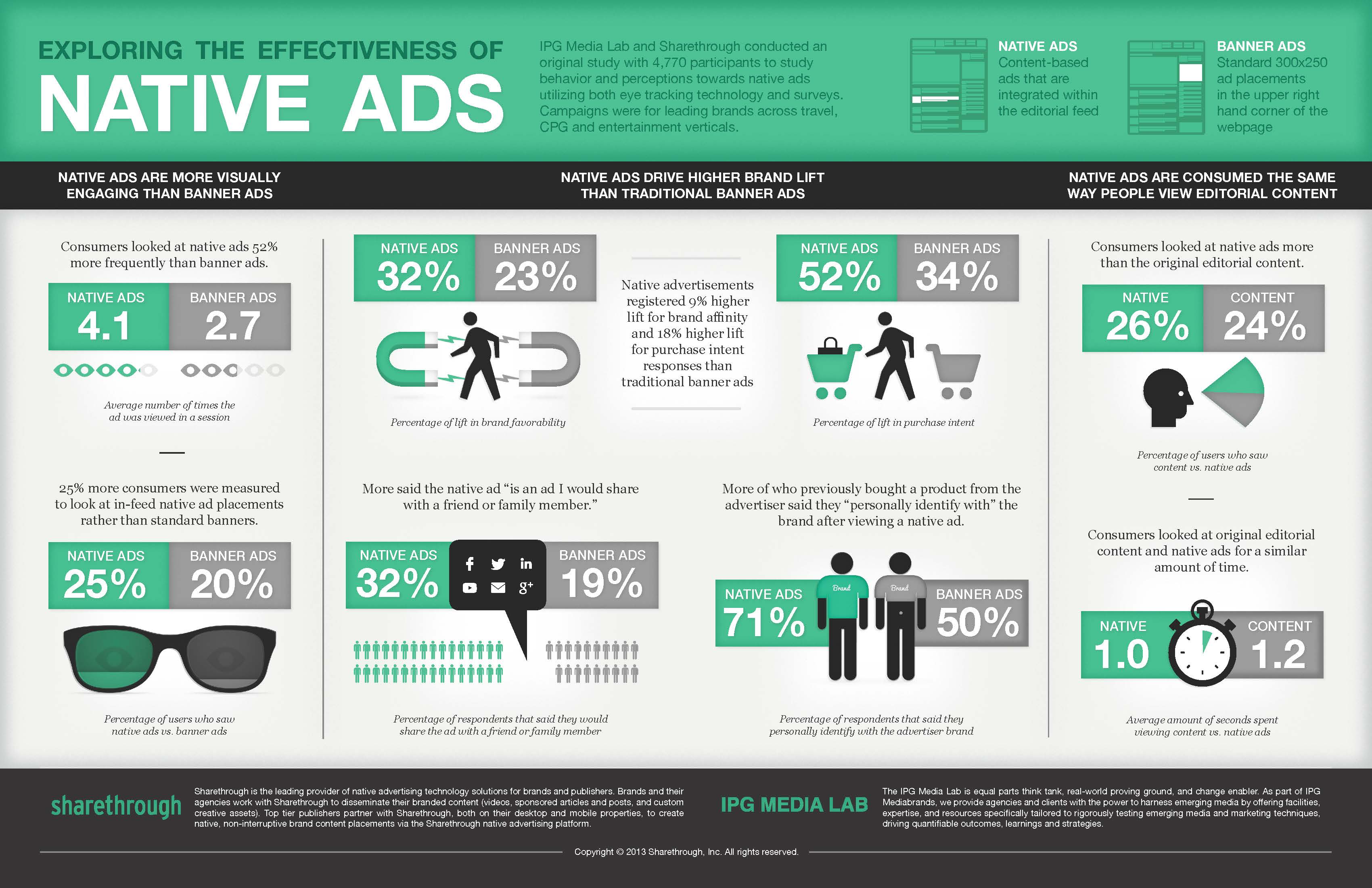
Definitions of native advertising still vary
Native advertising has seen a growing chorus of interest among publishers and ad buyers. Integrating sponsored content into digital channels has opened new doors for marketers to reach distracted consumers and provided publishers with new opportunities to generate ad revenue.
According to a June 2013 survey from the Online Publishers Association (OPA) and Radar Research, while many publishers may still be experimenting with how and what native advertising they will offer, most have already rolled out some native ad opportunities. Nearly three-quarters of polled US publishers said that they already offered native advertising on their site, and another 17% said they were considering offering it this year. Only 10% had no native ad plans of any kind.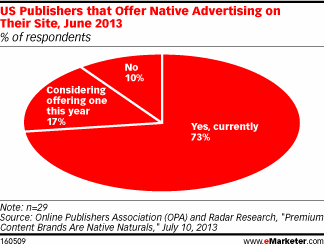
But even as more publishers roll out native advertising, there is still variation in how they think about and begin to define the new ad products. Nearly all publishers attested to the most essential definition of native advertising as “integration into the design of the publisher’s site and [an ad that] lives on the same domain.†And nearly nine out of 10 also said that native advertising was “content produced in conjunction with the advertiser, or by the advertiser, that runs within the editorial stream.†A slightly lesser 79% believed native advertising must be clearly delineated and labeled as such.
These may be crystallizing as the central tenets of native advertising.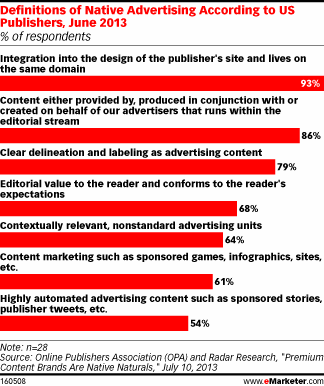
To evaluate their native ad campaigns, publishers said engagement was the leading metric marketers used, cited by 57% of respondents. That was followed by traffic, at 43%. Social sharing came in at one-third of respondents, indicating that while advertisers may want to get consumers sharing their native ad posts, this is not their No. 1 priority.
Market research company BIA/Kelsey estimated in April that this year, US native ad spending on social sites will reach $2.36 billion, or 38.9% of total US paid social ad expenditures. By 2017, social native ad spend will grow to $4.57 billion, and its share of social spending will inch up a few percentage points to 41.7%. But with native advertising reaching into so many digital channels besides social, this is likely far below the total outlays that will go toward native ads in all their different iterations.
eMarketer
DealerNet Services
 By using an omni-channel approach, the Topshop brand has generated a year’s worth of average Facebook activity in just four days. Photograph: Kin Cheung/AP The exponential growth of digital has created an environment that 20 years ago didn't exist, and even today we are still finding our way around it.
By using an omni-channel approach, the Topshop brand has generated a year’s worth of average Facebook activity in just four days. Photograph: Kin Cheung/AP The exponential growth of digital has created an environment that 20 years ago didn't exist, and even today we are still finding our way around it.Young people have grown up in this digital environment and are unafraid to use it. What is clear is that if we want to survive and prosper in this new digital era, we need to look at not only what it can do for our brands, but also what it can't.
And the one thing that online can't reproduce is the physical interaction between your consumer and the product. Offline gives us the opportunity to fulfil other senses that are involved in making a purchase. A physical place is somewhere to return a product, to have a conversation with someone face-to-face. It's a place where an issue can be resolved immediately. Online customer service has a lot to live up to.
In a recent survey, 60% of respondents said that they expected converged retail channels to be the norm by 2014. But more than half of shoppers said that most retailers lack consistency in the way they present themselves across channels.
Your customers will trust someone who is reliable, consistent in what they say, how they say it and what they promise. But more importantly, they expect to have the same brand experience wherever and whenever they interact with your brand.
The future is omni-channel By 2014, nearly everyone in western Europe and the US will have access to a smartphone connected to the internet. The world is already populated by brand-savvy consumers who are now in control. They say where and when they want to shop, and in some cases, what they are prepared to pay for a product. Retailers can't afford to let any moment of their customer brand experience to be less than rewarding, responsive and reliable.
The future is omni-channel: a mix of all the different ways people like to shop, blended together but all saying the same things. This means in store, on the web, through mobile, TV and social media.
Global research expert Forrester has speculated that the future consumer will want not just responsive interactions but adaptive ones, with content delivered in a way that best suits them as individuals, and their particular device.
Digital experiences will need to be more contextual, possibly including location, purchase history and recommendations. Devices will sync together and with other products allowing people to order from one device and check progress of delivery from another. And information visualisation – shortened to "infovis" – will need to be mainstream.
Brands taking the leadAlthough this digital integration is still in its infancy, some brands are already beginning to adopt it, including Burberry, Topshop, Hollister and M&S. Topshop recently launched a campaign where shoppers received a free styling and make-up session and were invited to create a digital 'Wish you were at Topshop' postcard using Instagram.
Once the postcard photo had been taken, they were given a copy to take home and were also able to upload it to Facebook and the Topshop gallery. To date it has generated 640 blog posts, with a reach of 1.4 million, as well as 5.3m views on Facebook and 2,000 comments. That's a year's worth of its usual Facebook activity in just four days. And as a result, it has become the number one fashion retailer on Instagram.
Or take M&S, a stalwart of the high street, yet embracing online and offline integration with Wi-Fi in store. The brand is also investing in connecting mobile web to the in-store experience. M&S sales assistants will carry tablet devices, and touchscreen kiosks are placed throughout stores to engage shoppers and make customer service easier.
If all channels are connected, customers can start their journey on one channel and complete it on another, creating seamless experiences that increase convenience and engagement, and with consistent brand experience.
Written by Max Eaglen
DealerNet Services
 The psychology of color as it relates to persuasion is one of the most interesting—and most controversial—aspects of marketing.
The psychology of color as it relates to persuasion is one of the most interesting—and most controversial—aspects of marketing.
The reason: Most of today’s conversations on colors and persuasion consist of hunches, anecdotal evidence and advertisers blowing smoke about “colors and the mind.â€
To alleviate this trend and give proper treatment to a truly fascinating element of human behavior, today we’re going to cover a selection of the most reliable research on color theory and persuasion.â¨
Misconceptions around the Psychology of Color
Why does color psychology invoke so much conversation … but is backed with so little factual data?
As research shows, it’s likely because elements such as personal preference, experiences, upbringing, cultural differences, context, etc., often muddy the effect individual colors have on us. So the idea that colors such as yellow or purple are able to invoke some sort of hyper-specific emotion is about as accurate as your standard Tarot card reading.
The conversation is only worsened by incredibly vapid visuals that sum up color psychology with awesome “facts†such as this one:â¨

Don’t fret, though. Now it’s time to take a look at some research-backed insights on how color plays a role in persuasion.â¨
The Importance of Colors in Brandingâ¨
First, let’s address branding, which is one of the most important issues relating to color perception and the area where many articles on this subject run into problems.
There have been numerous attempts to classify consumer responses to different individual colors:â¨

... but the truth of the matter is that color is too dependent on personal experiences to be universally translated to specific feelings.
But there are broader messaging patterns to be found in color perceptions. For instance, colors play a fairly substantial role in purchases and branding.
In an appropriately titled study called Impact of Color in Marketing, researchers found that up to 90% of snap judgments made about products can be based on color alone (depending on the product).â¨
And in regards to the role that color plays in branding, results from studies such as The Interactive Effects of Colors show that the relationship between brands and color hinges on the perceived appropriateness of the color being used for the particular brand (in other words, does the color "fit" what is being sold).â¨
The study Exciting Red and Competent Blue also confirms that purchasing intent is greatly affected by colors due to the impact they have on how a brand is perceived. This means that colors influence how consumers view the "personality" of the brand in question (after all, who would want to buy a Harley Davidson motorcycle if they didn’t get the feeling that Harleys were rugged and cool?).â¨
Additional studies have revealed that our brains prefer recognizable brands, which makes color incredibly important when creating a brand identity. It has even been suggested in Color Research & Application that it is of paramount importance for new brands to specifically target logo colors that ensure differentiation from entrenched competitors (if the competition all uses blue, you'll stand out by using purple).
When it comes to picking the “right†color, research has found that predicting consumer reaction to color appropriateness in relation to the product is far more important than the individual color itself.⨠So, if Harley owners buy the product in order to feel rugged, you could assume that the pink + glitter edition wouldn't sell all that well.
Psychologist and Stanford professor Jennifer Aaker has conducted studies on this very topic via research on Dimensions of Brand Personality, and her studies have found five core dimensions that play a role in a brand’s personality:

(Brands can sometimes cross between two traits, but they are mostly dominated by one. High fashion clothing feels sophisticated, camping gear feels rugged.)
Additional research has shown that there is a real connection between the use of colors and customers’ perceptions of a brand’s personality.â¨
Certain colors DO broadly align with specific traits (e.g., brown with ruggedness, purple with sophistication, and red with excitement). But nearly every academic study on colors and branding will tell you that it’s far more important for your brand’s colors to support the personality you want to portray instead of trying to align with stereotypical color associations.â¨
Consider the inaccuracy of making broad statements such as “green means calm.†The context is missing; sometimes green is used to brand environmental issues such as Timberland’s G.R.E.E.N standard, but other times it’s meant to brand financial spaces such as Mint.com.
And while brown may be useful for a rugged appeal (think Saddleback Leather), when positioned in another context brown can be used to create a warm, inviting feeling (Thanksgiving) or to stir your appetite (every chocolate commercial you’ve ever seen).
Bottom line: I can’t offer you an easy, clear-cut set of guidelines for choosing your brand’s colors, but I can assure you that the context you’re working within is an absolutely essential consideration.
It’s the feeling, mood, and image that your brand creates that play a role in persuasion. Be sure to recognize that colors only come into play when they can be used to match a brand’s desired personality (i.e., the use of white to communicate Apple’s love of clean, simple design).
Without this context, choosing one color over another doesn't make much sense, and there is very little evidence to support that 'orange' will universally make people purchase a product more often than 'silver'.
Color Preferences by Gender
Perceived appropriateness may explain why the most popular car colors are white, black, silver and gray … but is there something else at work that explains why there aren’t very many purple power tools?â¨
One of the better studies on this topic is Joe Hallock’s Colour Assignments. Hallock’s data showcases some clear preferences in certain colors across gender.â¨
It’s important to note that one’s environment—and especially cultural perceptions—plays a strong role in dictating color appropriateness for gender, which in turn can influence individual choices. Consider, for instance, this coverage by Smithsonian magazine detailing how blue became the color for boys and pink was eventually deemed the color for girls (and how it used to be the reverse!).â¨
Here were Hallock’s findings for the most and least favorite colors of men and women:â¨
Men’s Favorite Colors

Women’s Favorite Colors

Men’s Least Favorite Colorsâ¨

Women’s Least Favorite Colors

The most notable points in these images is the supremacy of blue across both genders (it was the favorite color for both groups) and the disparity between groups on purple. Women list purple as a top-tier color, but no men list purple as a favorite color. (Perhaps this is why we have no purple power tools, a product largely associated with men?)
Additional research in studies on color perception and color preferences show that when it comes to shades, tints and hues men seem to prefer bold colors while women prefer softer colors. Also, men were more likely to select shades of colors as their favorites (colors with black added), whereas women were more receptive to tints of colors (colors with white added):


Keep this information in mind when choosing your brand’s primary color palette. Given the starkly different taste preferences shown, it pays to appeal more to men or women if they make up a larger percentage of your ideal buyers.â¨
Continued here The Psychology Of Color In Marketing And Branding
Written by Gregory Ciotti
DealerNet Services
 Brands, companies, and individuals -- I think it’s time for some real-talk about content and social media. Gary Vaynerchuk recently gave an interview about his decision to employ a full-time stalker (a.k.a “content personâ€) to chronicle, translate, and transcribe his every movement and remark into micro-content for various social media.
Brands, companies, and individuals -- I think it’s time for some real-talk about content and social media. Gary Vaynerchuk recently gave an interview about his decision to employ a full-time stalker (a.k.a “content personâ€) to chronicle, translate, and transcribe his every movement and remark into micro-content for various social media.While I respect Vaynerchuk’s incredible success and agree with his sentiment that micro-content and content in general is incredibly important to the future of business, I question whether encouraging brands and companies to develop this type of content is really what leaders in the social world should be doing.
This massively successful Slideshare presentation speaks to the already overwhelming amount of useless content we experience on a day to day basis. It states that “the single greatest threat to content marketing is content marketing.†The deluge of shoddy, slapped-together content and micro-content that content shops, farms, and agencies are churning out in an attempt to keep up with the growing desire for more and more media is actually what is making us (the collective number of people “listeningâ€) numb to content of quality.
I’m beginning to notice a “content double-take,†where readers are so glazed over scrolling through endless LOLcat updates and tweets about food that they almost (or sadly, sometime do) miss an incredibly important piece of content and have to scroll back to it after the few seconds it takes to sink in.
For instance how many reading actually know what’s happening in Turkey? Or that ExactTarget was acquired by Salesforce for billions of dollars? Or any equally important, business-specific update. I am totally guilty of this “double-take†predisposition and I’ve often missed opportunities to learn, grow as a consumer of content, and be informed about important, bottom-line impacting events. I’ve missed the chance to provide immense value to my community because of precisely the type of content Vaynerchuk is championing.
Do we, the brands and companies with the resources to develop consistent streams of content, want to build a culture of “fast food consumerism†around content and social media? Do we want to actively encourage QWERTY-vomit instead of meaningful, thoughtful insights that could actually benefit another human? Do we want to say without words that “fast and easy†holds more value than “thoughtful and creative?†Should the leading voices in this space really be creating and supporting this type of content?
I don’t think so.
We, as a collective, should be focusing on creating a smarter, more beneficial internet -- for everyone. Web media and the internet’s immense index of knowledge is fundamentally changing the way we learn and communicate across the world. It is the unspoken responsibility of those creating and pushing content (especially from high places) to not muck that up! A recent survey shows that 67.5% of professionals use social media to find and consume content for professional reasons every single day, and this percentage will only grow as more people around the world get connected to social networks.
It is our responsibility to do more, be better, and produce higher-quality resources than we did yesterday. People all over the world are looking to us, as leaders, for inspiration, guidance, and insight -- that they could follow in our footsteps and also be more than the sum of their parts. Failing to recognize this, or recognizing this fact and choosing to ignore it for the “easier†path, is negligent, insular, and selfish.
You may be saying to yourself “well, all that idealistic ‘we can make the world better’ sentiment is nice and all, but I really just care about my bottom line.†I respect your position as a business person but, unfortunately, the point that value and insight should be driving your content development still stands (see above, where 67.5% of professionals use social media to find and consume professional content every day). Diluting the landscape with meaningless drivel produces a more complex, chaotic content landscape that will actually make people pay attention to you less, which, at the end of the day, is the opposite of what we (as brands and business) want.
Let’s be real. More likely than not, if you are reading this, you are not in that top “1-5%,†which means you already have to go above and beyond to be heard through the noise on social media and the web in general. Do you really want to make this more difficult for yourself? Do you want to become a monotonous voice of constant, meaningless communication in a sea of identical monotonous voices or do you really want your message to shine and drive significant impact? Consider this: a recent poll of professionals on the Scoop.it platform presented data that one piece of high-quality content had brought in over $50,000 on average over the lifetime of that content.
A more organized and valuable internet benefits the world, our brands, and our future leaders for the long tail -- not just the short-term vision of the “top 1-5% of executives and social media personalities.†Random updates from the days of these top 1-5% won’t spark creativity or innovation -- the absolutely priceless insight and perspective which the positions of this top 1-5% afford them is what will inspire and help create the leaders of tomorrow. Brands and personalities should be known for who they are, what they stand for, and what they are best at -- not who can create the biggest firehose of social media data.
Who am I to say these things? No one, just a humble content person with a bigger vision for social media and content than tweets with no vowels. Someone who was inspired to do this work because of the incredible insights and sincerity I saw from the brands and online personalities that catapulted social media to its position in the ecosystem of the internet today.
I ask you, brands, companies, and individuals as a peer and fellow creator -- do you want to be remembered because you had amazing, beautiful, insightful things to give to the world or do you want to be remembered because you just wouldn’t shut up? The choice is yours.
ByClair Byrd
DealerNet Services
 What sets your company apart from everyone else’s? It’s the brand – and creating a better business starts with this key factor. Without a really good one, nothing sets your enterprise apart from the next one, and this won’t have customers clamoring to do business with you. Therefore, take a hard look at this aspect of your company, and figure out where any changes need to be made. Your business’s brand is essentially your promise to your customer, according to Entrepreneur magazine, and it sets the tone for all future relations. It is what sets you apart, and it is a reflection on everyone who works for a company. With a poor one, even the best products and services could be ignored. When it comes to branding your business, be the industry standard. Let customers know exactly what they are dealing with and the quality of services they should expect.
What sets your company apart from everyone else’s? It’s the brand – and creating a better business starts with this key factor. Without a really good one, nothing sets your enterprise apart from the next one, and this won’t have customers clamoring to do business with you. Therefore, take a hard look at this aspect of your company, and figure out where any changes need to be made. Your business’s brand is essentially your promise to your customer, according to Entrepreneur magazine, and it sets the tone for all future relations. It is what sets you apart, and it is a reflection on everyone who works for a company. With a poor one, even the best products and services could be ignored. When it comes to branding your business, be the industry standard. Let customers know exactly what they are dealing with and the quality of services they should expect.
It all starts with the logo
Not surprisingly, one of the first elements of a brand people see is the logo. That is why it is crucial to make it the best it can possibly be. The logo can make or break a company, and while it is often the first element seen, it can frequently be the last thing remembered. Think about all of the iconic logos - BMW, Coca-Cola, Nike – the list could go on for a long time, but the point is that they are all quite memorable in their simplicity. This is the ultimate goal for branding your business. Create the perfect logo so a customer can’t get it out of their head.
“Other people have to be able to speak for your brand,†said Jonah Berger, associate professor of marketing at the Wharton School of the University of Pennsylvania. “You love your company, you think your company is great, but if you’re not around, what are people going to be able to remember? And what are they going to tell others?â€
Therefore, when starting to craft a brand identity, it is best to keep it simple. The iconic logos previously mentioned all had something in common – simplicity. That is one of the major reasons as to why each one stays in your head. They manage to convey a lot about a company while not being distracting or overly ambitious. For example, Apple started with a more complex version of the logo we all know today. If you remember, it used to be rainbow-colored, and the more intricate predecessor of the plain, black or grayscale version apparent on many tech items today. Berger added that the easier it is to look over a logo, the more desirable it becomes. Apple was smart to simplify - it was less difficult to see the apple and remember with less bells and whistles. Most of the iconic logos have fewer than three colors, and this is for good reason.
To make a company really stand out over a long period of time, the logo also needs to be flexible. What this means is that a company can’t get locked in to an idea. Something that works now might not work in five years, or 10 years, and so on. Perhaps it may not even work in a shorter amount of time, and it is up to management to be able to change quickly and not let affection or ego cloud good business strategy. For example, the Apple logo speaks perfectly to this. The rainbow-colored one was great when the company was a fraction of the global giant it is today, but things change, and the bright, multi-faceted fruit doesn’t convey the same connotations that its monotone counterpart does now.
All of these elements speak to memorability. Don’t make it difficult for a customer to remember your business. Help them along, and at the same time try to convey as much as possible about what the company does. Take a simple concept and give it a small slice of spice, like when Apple decided to take a bite out of its logo.
A great brand should “help them remember that you exist and what you stand for,†added Berger - without a little variety, “it might be easier to process, but [you'd] be less likely to remember, because it looks exactly like a million things you’ve seen before.â€
The best way to know if the methods you use for branding your business are working it to try them. Put a new logo out there and see what people think.
Keep your brand short, sweet, and adaptable
The concepts many businesses use for marketing change often. If your company can’t change right along with them, odds are it won’t succeed. According to Inc. magazine, the old themes of business marketing involved creating a product that has broad appeal, reaching an audience as large as possible and creating a recognizable brand name that can span multiple products. While elements of these hold true in some fashion, the marketing world is evolving, and your company should too.
Due to the growing technologies available today, it requires a different touch to brand well. The Internet and media have divided consumers into smaller categories, and it has also shortened attention spans and has turned many people into the “what have you done for me lately?†types. Therefore, the strategies you use need to be customized to appeal to very specific consumers.
Therefore, a great business brand should target a specific type of person - one that is most likely to buy your product. This brand should attempt to gain support among these consumers, which will help bring new business in. In addition, customer feedback will help define your brand in the future, setting the tone for future marketing strategies. Listen to everyone - social media can be a great way to get instant opinions.
New strategies are more narrow than the older ones, and a business really has to know who its clientele is. The best method for branding your business is to let your consumers dictate the direction. What makes your brand memorable, and what branding strategies do you want to implement in the future?
by Amy Atwood
DealeNet Services
Â
Most C-level Executives, CMO included, View “Social†as Media but…
Tags:
 Most C-level Executives, CMO included, view “Social†as media—but they don’t know how to interact with consumers there in a meaningful way. They want to buy CPMs or Likes—but don’t know what to do with them afterward.
Most C-level Executives, CMO included, view “Social†as media—but they don’t know how to interact with consumers there in a meaningful way. They want to buy CPMs or Likes—but don’t know what to do with them afterward.
CMO’s also make the mistake of assuming that the social audience has the same pain and passion points as their face-to-face or store audience. Most often that is not the case.
In order to get the real value out of Social, you must connect emotionally to the people who are there and find out what they’re looking for. CMOs are used to ads and campaigns, so that’s the place they gravitate, but even Facebook ads are only media buys. Ads are good for building initial likes, but they really are targeted to demographics just like any other ad.
Your mission is to go beyond that initial like and really get people excited about your brand, engage with you, buy from you, become a social advocate and sell for you. To do that you need to get into the heads of your social buyers.
So assign that as a singular goal to appropriate personnel on your team. Make it their mission to follow or friend your followers (not only on Facebook and Twitter, but everywhere online) and listen to their conversations. Their sole mission should be to pay attention to your social consumers. Find out what they like to talk about, the other brands they like, what their problems are–what makes them tick. That’s not a one-and-done task either… it’s ongoing.
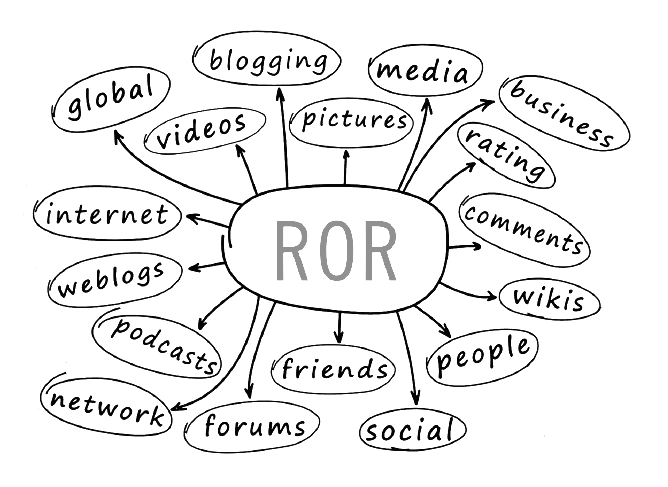
by Ted Rubin
DealerNet Services
 Have you noticed that more and more ads have been creeping into Google’s search results over the last few years? The result is that all the actual search results (known as “organic†results) are being pushed further and further down the page. The Problem In the screenshot below you can see the Google Ads highlighted in the red rectangles. This is what the Google results page looks like if I search for “Brisbane mechanic†on a laptop with a screen resolution of 1280×800, which is fairly common for 14″ or 15″ laptops (different screen resolutions will show more or less of the results page). As you can see, only two organic results show on the page without needing to scroll down. The content that shows at the top of the page without having to scroll down is known as being “above the fold“. In the same space there are SIX ads! Not to mention the ads get pride of place at the top of the screen, encouraging more people to click on them.
Have you noticed that more and more ads have been creeping into Google’s search results over the last few years? The result is that all the actual search results (known as “organic†results) are being pushed further and further down the page. The Problem In the screenshot below you can see the Google Ads highlighted in the red rectangles. This is what the Google results page looks like if I search for “Brisbane mechanic†on a laptop with a screen resolution of 1280×800, which is fairly common for 14″ or 15″ laptops (different screen resolutions will show more or less of the results page). As you can see, only two organic results show on the page without needing to scroll down. The content that shows at the top of the page without having to scroll down is known as being “above the fold“. In the same space there are SIX ads! Not to mention the ads get pride of place at the top of the screen, encouraging more people to click on them.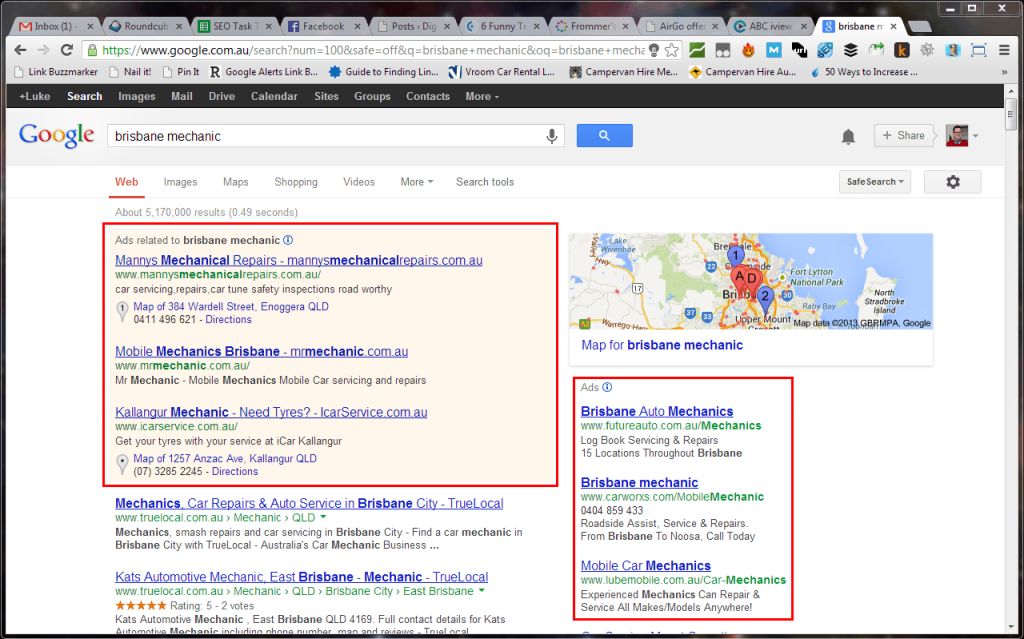
For some results there aren’t ANY organic results above the fold. That means everything you see after you search is advertising!
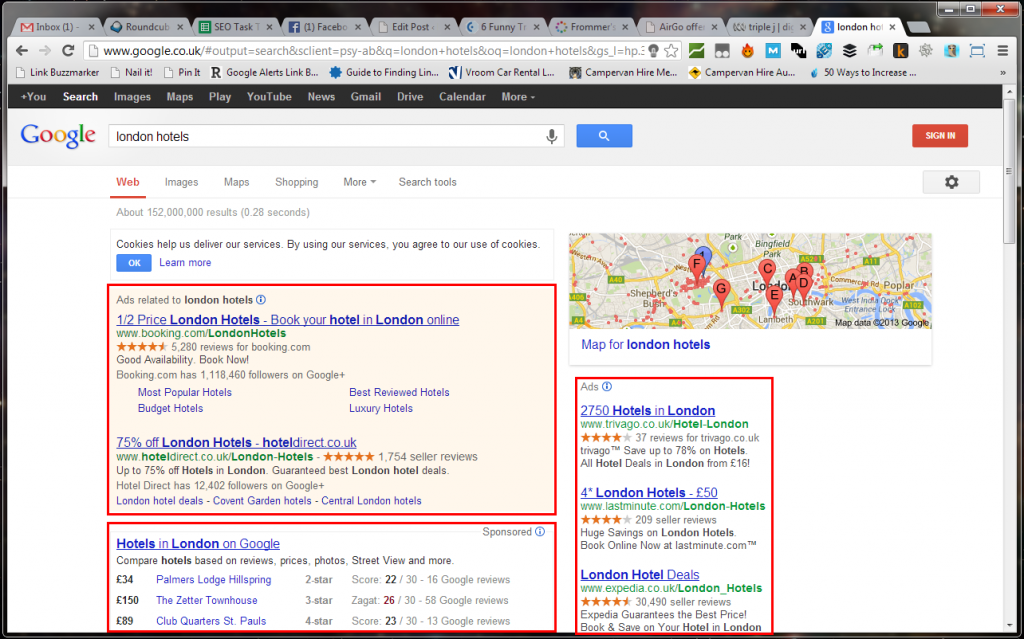
What Else Can I Do? “I want to rank number 1 on Google†is not a valid digital marketing strategy. Even less so now that the actual organic listings are being pushed so far down the page. The good news is there are so many other things that you can be doing to improve traffic to your website other than “traditional†SEO. Here are some ideas to get you started.
- Embrace social media. I don’t mean go and post funny cat photos on Facebook. I also don’t mean to go and buy a bunch of fake Facebook likes on Fiverr. I’m talking about actually being social. This gets right to the heart of what social media is about. Do some research and find out where your target market is active online – is it Facebook? Twitter? Pinterest? TripAdvisor? The answer will vary depending on your industry and the demographics of your target market. Once you know where your target market is, go and be social with them! Think about what that means. Is standing on a soap box yelling about your latest products or services “being social� No! Yet that’s exactly what most companies do on their social media accounts. What you should be doing instead is being helpful, getting involved in conversations and solving people’s problems.
- Become the authority for information or news on your topic. Seek out and write for relevant publications that may reach your target audience. A good way to do this is to look on websites like SourceBottle for journalists and bloggers that are seeking sources for their articles. Get in contact when they’re looking for something that you can help with, and you’ll often end up in a magazine, newspaper or on a website appearing as the expert on a certain topic, with a link to your website.
- One of the best ways to get extra exposure and PR is to network with other people in the industry, and with opinion leaders. Do the groundwork and build up these relationships and it will pay off in the longer term. If you need help with networking, I’d highly suggest reading Never Eat Alone by Keith Ferrazzi.
- Make the most of your existing customers and website traffic by getting them to sign up to regular e-mail newsletters. Once a month or quarter may be enough, depending on your website. Don’t send out updates just for the sake of it. Offer something interesting, insightful, newsworthy and/or funny. This will keep people coming back to your website and keep your brand front-of-mind.
- Find relevant blogs and comment on them. You’re not commenting for the power of the backlinks, but once again to help build your name as an expert and someone helpful. Be sure to use your name (not your company name) as this will make it much easier for people to relate to you, and you’ll come across as much more genuine and approachable.
- Go the extra mile for your customers. Word of mouth always has been (and still is) one of the most powerful forms of advertising you can get. Your customers will become advocates for your company (and website)!
- Branding is super important. Make sure your brand is consistent and easily recalled by customers. A nice clean website design is also important, as bad design can result in visitors clicking the back button straight away. Come up with a great tagline or business name and it will stick in people’s minds much longer. Guess who they’ll think of when they need the product or service that you provide?
by Luke Chapman
DealerNet Services
Reeling Them In! How to make your Website Work Harder For You
Tags:
Previously seen as an afterthought, more companies are seeing the value to be had in actively improving their website.
Is your company’s internet presence going unnoticed? This might be because what you thought was the hard part, has only just begun. These days it’s not enough just to simply have a website to bring in visitors, you have to actively make it an attractive destination for consumers who are surfing the web. The Internet can play an important role in marketing your business, however you have to know how to make it work for you.
Your online presence can be seen in two phases. The first is successfully bringing people to your page, while the second is keeping them there long enough for your message to have been communicated. The following are some tips that can both increase the traffic that is coming to your site and encourage people to continue looking once they have arrived.
Reeling them in
Events on the Internet happen in the blink of an eye. This means that you need to keep your website fresh and up to date if you want to see it coming to the top of the Google and Bing searches. Strategies like maintaining a blog or a current news feed are easy ways in which to keep the content on your website fresh and give people new reasons to visit your site.
Having said that, it is important to keep the content you publish meaningful. If you are simply posting the same thing using slightly different terminology, not only are you compromising the quality of your website, you are not doing meaningful work to improve your website’s search engine optimization, as search algorithms can decipher deliberate attempts to put as many keywords on your website as possible. But if you truly believe the work that you do is important and can offer invaluable service to your customers, content should be able to flow with a little bit of insight.
Keeping visitors engaged
So you having given them a reason to visit, the challenge is being a good host and giving your guests a reason to stay. Inc. Magazine explains that websites can be viewed in a sense like newspapers. In the “olden days†of hardcopy newspapers, the attention grabbing news stories would be listed “above the fold,†meaning they would be the first thing that a reader saw so as to draw them into the paper. This concept can be applied to your website as well, by making the most attention grabbing and attractive pieces of content the easiest to access. It is only so much to have a great piece of content – you have to put it in a place that makes visitors want to see it.
Software can now point out where the highest and lowest amounts of traffic on your website are arriving, and in doing so, see what sections are receiving the most action. If you notice that a particular page is not being visited nearly as much as others others, you may want to consider where its short comings lie. It could simply be that it is in a difficult to reach spot or it could be that people are not interested in the information it has to offer. This should prompt you to evaluate what it is this particular page is doing for your site. If you feel that information is important for your visitors, it should be put in an easier to access location, but if you feel like it might be extraneous, it probably is.
A website is all about giving potential customers a reason to visit and a reason to stay. What forms of content have you used to accomplish these goals?
Article by by Chelsea Segal Intro by DealerNet Services
Your Copywriter Don't Dance and Your Content Don't Rock 'n' Roll [PODCAST] Shake it up Baby!
Tags: If you haven't heard this it's great. If you have it's worth another listen
If you haven't heard this it's great. If you have it's worth another listen
“The Point – In Your Ear†is back sneering at crappy content like the king of rock and roll. In this wild tale, you’ll hear about a street corner advertising rock star, the ho-hum state of online content, the point of view of advertising legend Tom McElligot, how content is too much like merlot, and why you need to step on some blue suede shoes.
It’ll all make sense 9 minutes from now. Enjoy.
Follow this link:Â Podcast
The story begins...
A street corner advertising rock star.
Her job is to generate traffic to the Verizon Wireless store. She has no props. Nor does she hawk an offer you haven't seen a million times. Sounds, pretty ho-hum, I know. But day after day, she's doing her thing on the well-traveled corner of Green Valley and Francisco and she calls a ton of attention to herself and the store. I bet she actually does generate traffic. And I'd bet you an hour wages, she's paid several shillings more than minimum wage. Why?
She dances. Enthusiastically. Oddly, actually. Relentlessly. She has an iPod in her pocket, earbuds in her ears, music in her heart, and she never stops dancing. And believe me, she doesn't dress like or move like a Dallas Cowboys cheerleader. And if you're wondering if she'd cut it on "So You Think You Can Dance," the answer is no chance.
She doesn't bring amazing talent to her extremely unusual profession. She brings originality and passion.
Let's talk about online marketing now.
Listen to the podcast now
http://dealernetservicesonline.biz
Â
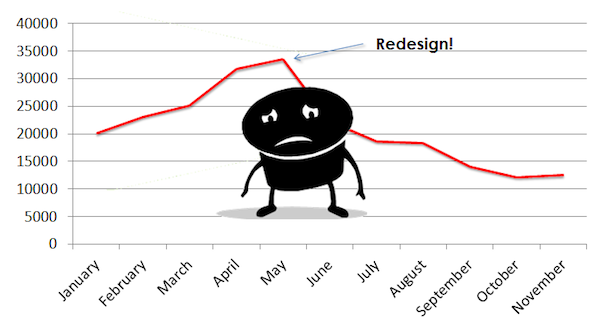 Planning a website redesign can be an extremely exciting process. You have a blank canvas to which you can easily add your own creativity and flair. It's tempting to get carried away.
Planning a website redesign can be an extremely exciting process. You have a blank canvas to which you can easily add your own creativity and flair. It's tempting to get carried away.
Unfortunately, most designers and creative teams will use this opportunity to focus entirely on the visual design of the site, and overlook SEO, content, and functionality.
Sites with a history of good search traffic can see most or even all of that traffic vanish after a redesign. That new site may look great, but that won't be much consolation to their owners!
Yes, it's important to have a great looking website. It needs to look great if it's going to convert your visitors into paying customers, but traffic, conversions, and functionality are what will ultimately govern its success or failure.
So, what are the key considerations when implementing a site re-design?
1. Have You Done Your Research?
To design a website that's going to deliver results, you need to know who you're targeting. The design, functionality, and SEO focus should all be dictated by informed research. That means market research, keyword research, and community mapping.
This should be your first port of call, not an afterthought. If you have this information from the very beginning you can then use in in every aspect of your redesign.
Benchmarking your existing data will allow you to identify what is currently working, and what has worked in the past. Be sure to evaluate which pages are the most popular, convert the best, rank and deliver the most leads/sales. Doing so will fuel the new site with proven techniques and allow you to gauge the site's success post-launch.
2. Website Structure
A redesign isn't simply a chance to give your website a fresh look. It also gives you the opportunity to reorganize the way your site is structured.
To make sure your information architecture is set up for optimal visibility and conversions, your priority should be analyzing the effectiveness of your current site:
- Which pages convert the best?Â
- What's the most common route through your website?Â
- Do some pages have a high bounce rate?
Use all of this information to improve the architecture of your new site.
Mobile phones, tablets and alternative devices must also be considered. There are a few primary approaches:
- Responsive
- Adaptive
- Mobile site
- Apps
Each approach has their advantages. You'll want to consider factors like site goals, personalization, site complexity, timeframe, and budgets.
3. Redirects – 301 & Canonicals
Inventory all pages, incoming links, and pages that rank well from the very beginning. Don't forget about subdomains.
As the URL structure is changed, a redirect strategy will be incredibly important to retaining any SEO rankings and rerouting referral traffic to the new pages/URLs.
Audit and analyze where all incoming links are coming from, and going to. This can be done using tools like Open Site Explorer and Majestic SEO, among others.
Once you have an inventory of backward links, you'll want to map them along with all pages to their new location using 301 redirects. This is also a great time to establish your canonical strategy for "www", index files, and other forms of duplicate content.
Tip: The redirect strategy will likely change based on design, navigation, and content, among other factors. Knowing this in advance will help alleviate future frustrations.
4. Navigation
How easily your site can be navigated, by both human visitors and search engine spiders, will have a significant effect on the visibility and success of your new website. You need to look at site structure from two different standpoints:
-
How are people going to find your site? This is where you need to be thinking about your URL structure. Can it be shortened? Are there lots of unnecessary characters? Does the URL give pride of place to the term you'd most like that page to rank well for?
A redesign gives you the chance to give your entire URL structure a reshuffle and cut away any dead wood that may have developed as part of your existing site's development. Your new URL structure and sitemap should make it easy for the search engines to see what each page is about and make sure that you're using the most important terms for each of your campaigns. -
How your human visitors will navigate the site once they've found it? Which pages have you identified as your primary entry points? What action do you want visitors to each of these pages to take? What journey will they need to take in order to take that desired action? Can you do anything to shorten this journey or increase conversions?
By taking an informed, data-driven look at your existing site structure and optimizing it in line with your new site's primary objectives, you have a chance to drastically improve the performance of your site.
5. Where Does the Content Fit In?
We all know that content is the most important aspect of any digital campaign. So why is it still so often an afterthought when sites are designed?
The quality, visibility, and relevance of your content will be the most influential factor in determining the success or failure of your new site. Shouldn't it be given some attention during the design process?
One primary consideration is what type of content will be published on-site.
- Are you going to have a blog?Â
- Is that blog going to be mostly visual or will you be publishing long, informative articles?
These questions should always be answered before you start designing the site. This gives you the opportunity to effectively integrate the blog into the overall design of your new website. It will also give you a chance to make sure that visitors can always find the most relevant content for them – and that they can find your blog, no matter what page they're on.
Another consideration is whether you'll be offering any other content through your site.
- Will you be publishing whitepapers, eBooks, video tutorials?Â
- If so, how will they be delivered?Â
- Will you offer them in return for an email address?Â
- Will they be available to anyone, or only available to members?
As with each of the previous points, considering your content before you finalize the site design will make it far more functional, profitable, and effective.
6. Technical SEO
Your site's position in the SERPs depends on many different factors (more than 200, according to Google). This means that your redesign gives you more than 200 different areas that you can look to improve, condense, and build on to increase your search visibility, site authority, and trust.
Three key areas you should pay close attention to during the redesign process are:
- Page load times: Far too often companies launch a site that looks great, but only if you wait around for long enough for the homepage to load. Unfortunately, visitors to your site won't put up with it, and as a result, neither will the search engines. Your redesign should be seen as an opportunity to speed up your site, not slow it down.
- Compliance: This area is also often overlooked by site designers. If you want your site to work in the modern online marketplace it needs to conform to recognized standards. This means it needs to adhere to section 508 and W3C compliance factors as well as EU Cookie laws (if applicable).
- Coding: Your site redesign should be seen as an opportunity to give your code a spring-clean. As you know, search engine spiders can only read text. Images, videos and other web elements can all hide and disguise this text so that search engines have difficulty reading it. This means that they are also very unlikely to give your pages high visibility for those disguised terms. To ensure that your site has the greatest possible search visibility, you need to make sure that your code makes it as easy as possible for the spiders to crawl your site. If you're in any doubt, use a tool like this to see your pages from a search engines point of view.
7. Testing
In an ideal situation, budgets and time would be unlimited. If we had the budget and time, every single component of the site would be pitted in a death match fight to the death based on analytical data. This would include all wireframes, mock-ups, images, color, content and the list goes on.
Obviously, we can't do this. But don't forget about the advantages gained if we could, and remember to incorporate testing into your process.
Conclusion
Digital marketing is quickly evolving into an entirely integrated discipline. A website redesign is a major event in any digital marketing campaign, so it makes sense that this process should also be as integrated as possible.
If a site is going to deliver real value, it shouldn't be left to just designers and aesthetic considerations. Your SEO team, copywriters, sales team and social media managers should all be heavily involved, right from the start.
By Brad Miller
http://dealernetservicesonline.biz
CALENDAR
CATEGORIES
TAGS
TWITTER POSTS
CALENDAR
- powered by
- One Big Broadcast
- creative by
- WebStager
© 2025 One Big Broadcast | All rights reserved

